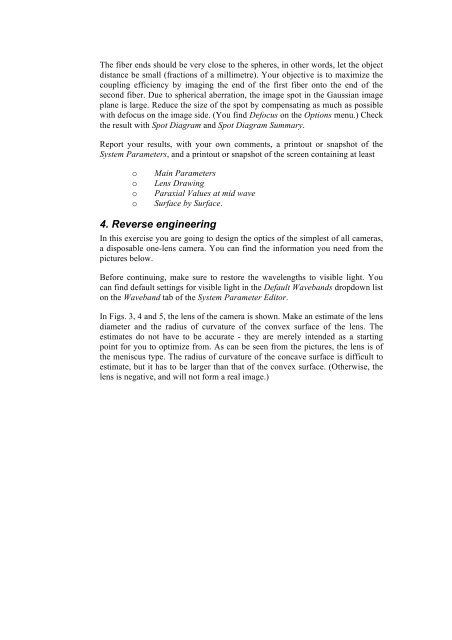Winlens lab instructions
Winlens lab instructions
Winlens lab instructions
Create successful ePaper yourself
Turn your PDF publications into a flip-book with our unique Google optimized e-Paper software.
The fiber ends should be very close to the spheres, in other words, let the object<br />
distance be small (fractions of a millimetre). Your objective is to maximize the<br />
coupling efficiency by imaging the end of the first fiber onto the end of the<br />
second fiber. Due to spherical aberration, the image spot in the Gaussian image<br />
plane is large. Reduce the size of the spot by compensating as much as possible<br />
with defocus on the image side. (You find Defocus on the Options menu.) Check<br />
the result with Spot Diagram and Spot Diagram Summary.<br />
Report your results, with your own comments, a printout or snapshot of the<br />
System Parameters, and a printout or snapshot of the screen containing at least<br />
o<br />
o<br />
o<br />
o<br />
Main Parameters<br />
Lens Drawing<br />
Paraxial Values at mid wave<br />
Surface by Surface.<br />
4. Reverse engineering<br />
In this exercise you are going to design the optics of the simplest of all cameras,<br />
a disposable one-lens camera. You can find the information you need from the<br />
pictures below.<br />
Before continuing, make sure to restore the wavelengths to visible light. You<br />
can find default settings for visible light in the Default Wavebands dropdown list<br />
on the Waveband tab of the System Parameter Editor.<br />
In Figs. 3, 4 and 5, the lens of the camera is shown. Make an estimate of the lens<br />
diameter and the radius of curvature of the convex surface of the lens. The<br />
estimates do not have to be accurate - they are merely intended as a starting<br />
point for you to optimize from. As can be seen from the pictures, the lens is of<br />
the meniscus type. The radius of curvature of the concave surface is difficult to<br />
estimate, but it has to be larger than that of the convex surface. (Otherwise, the<br />
lens is negative, and will not form a real image.)

















